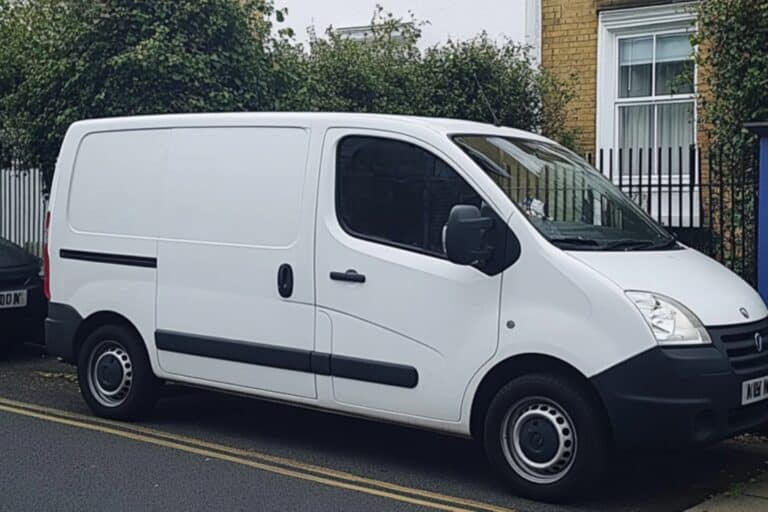The cost of a man and van service depends on various factors, including the distance of the move, the size and weight of items, and the time required to complete the job. Understanding these factors is essential for effective budgeting and planning. This article delves into the key elements that influence the overall cost of a man and van service and provides valuable insights to help you make informed decisions and avoid unexpected expenses.
Key Takeaways
- Key factors influencing the cost of man and van services include distance, size and weight of items, and time required for the job.
- Additional services such as packing, storage, and insurance can significantly increase moving costs but may offer valuable convenience.
- Moving costs vary by season and flexibility in scheduling can lead to substantial savings, especially by avoiding peak times.
Key Factors Affecting Van Service Costs
When planning a move, the cost of a van service is a critical factor. Various elements, including the move’s distance, the size and weight of your items, and the time required for the job, significantly influence the price. Seasonal demand and service location also play substantial roles in determining costs.
Being aware of these factors can help you better prepare and avoid unexpected expenses. Each of these elements will be examined in detail to give you a comprehensive breakdown of what to expect when hiring a man and van service.
Distance of the Move
The distance between your current location and your new home in Slough significantly impacts moving costs. Local moves, typically within a 100-mile radius, are often charged an hourly rate, making them more budget-friendly and easier to plan.
Long-distance moves, such as those crossing state lines or covering several hundred miles, generally incur higher costs due to increased fuel consumption, travel time, and logistical complexities. They often require more comprehensive planning and coordination, adding to the overall expense.
Tolls, overnight stays for the moving crew, and complex routing can further elevate costs. Understanding how distance impacts your moving service cost is crucial for accurate budgeting.
Size and Weight of Items
The size and weight of the items you plan to move also significantly affect costs. Larger vans are more expensive to hire due to their higher capacity and fuel needs. Heavy or bulky items may require additional manpower, further increasing expenses.
Accurately describing your load to the moving service helps prevent additional fees. Underestimating the volume or weight can necessitate multiple vehicles or trips, significantly increasing overall costs. Typically, 2 to 4 movers are required to handle a move efficiently, especially with heavier items or larger volumes.

Time Required for the Job
The time required to complete your move heavily influences the total cost. Most services charge by the hour, with a minimum of two hours to ensure proper compensation. If the move takes longer than expected, overtime charges may apply, adding to the final cost.
Factors such as the physical layout of your property can affect the time required for a move. Complex layouts with multiple flights of stairs or narrow access points can slow the process. Having your items well-organized and ready to go can speed up the move, potentially reducing time and cost.
Additional Services and Their Impact on Costs
Additional services offered by man and van moving companies can significantly influence the overall cost. While convenient, these services, such as packing, storage facilities, and insurance coverage, can add to the final price.
Consider whether these additional services are necessary for your move and weigh their benefits against the van cost. We will explore how these specific services impact the overall van service cost.
Packing Services
Professional packing services can increase the overall cost but offer significant convenience and protection. They save time and effort by ensuring that all items are securely packed and ready for transit with a service provider and a professional moving company.
Although packing services can increase moving costs, their benefits, such as efficiency and safeguarding items, can outweigh the expenses. If you have valuable or fragile items, professional packing services might be a cost-effective choice.
Storage Facility Use
Sometimes, a gap exists between moving out of your old place and into your new home. In such cases, using a storage facility might be essential. However, this convenience comes at an additional cost, as you will have to pay for the storage unit and transport expenses to and from the facility.
Insurance Coverage
Insurance coverage is a crucial aspect of man and van services, including public liability and goods-in-transit insurance. These protect against damages to your belongings and liabilities from accidents or injuries. While basic insurance is often included, additional coverage can incur extra costs.
For long-distance moves, insurance options provide additional peace of mind by covering belongings during the journey. Knowing the types of insurance available and their costs can help you make an informed decision and avoid unexpected expenses.
RECOMMENDATION
When budgeting for man and van services, consider the value and security of your belongings to decide if add-ons like packing, storage, and extra insurance are worth the investment. While these services may increase costs, they provide added protection and flexibility, especially for long-distance or complex moves.
Seasonal and Demand-Based Pricing Variations
The cost of man and van services can vary significantly depending on the time of year. Seasonal demand affects pricing, with spring and summer being peak seasons. During these months, higher demand drives up prices, making moves more expensive.
Flexibility with your moving dates can help you avoid peak charges. Scheduling your move during off-peak times, such as winter or weekdays, can lead to significant savings.
We’ll explore how peak and off-peak seasons affect costs and the benefits of flexible scheduling.
Peak vs. Off-Peak Seasons
August is often the peak month for moving services due to high demand. During these times, prices for moving services are generally higher. However, moving during off-peak months, such as winter, can lead to cost reductions.
Scheduling your move for less expensive times, like winter or weekdays, can result in significant savings. Planning during these off-peak seasons can be cost-effective.
Flexibility in Scheduling
Adaptability with your moving dates can help you avoid pricey peak periods and secure better rates. Adjusting to off-peak times can lead to significant savings. Booking in advance can also secure lower rates and improve availability.
Flexibility in scheduling helps reduce costs and makes the moving process less stressful by avoiding peak periods. This can result in a more relaxed and efficient move.
Local vs. Long-Distance Moves
The geographical area of your move significantly influences costs, with local relocations generally being more economical than long-distance ones. Local moves typically involve shorter distances and can often be completed within the same day, making them more budget-friendly.
In contrast, long-distance moves come with higher costs due to increased travel time, fuel consumption, and possible overnight stays for the moving crew. Understanding these differences can help you better plan your budget and anticipate potential expenses.
Local Moves
Local moves offer significant cost benefits compared to long-distance relocations. The reduced distance results in lower transportation costs, making them more budget-friendly. Typically, they involve less time and fewer miles, translating to lower overall costs.
These moves are often completed within the same city or region, which further reduces the complexity and expense involved. Local moves are a cost-effective choice for those relocating within a short distance.
Long-Distance Moves
Long-distance moves often come with higher costs compared to local relocations. Increased travel time and distance, along with per-mile rates, contribute to higher expenses. Additionally, fuel consumption and the need for overnight accommodation for the moving crew can further elevate costs.
Increased travel time and distance, along with per-mile rates, contribute to higher expenses.
These moves require more comprehensive planning and coordination, which can add to the overall expense. Understanding several factors that influence the cost of long-distance moves is essential for accurate budgeting.
Tips to Save Money on Man and Van Services
Planning is an effective way to save money on man and van services. Securing lower rates and avoiding additional charges can significantly reduce moving costs. Moving during the fall and winter months, as well as on weekdays, can also help reduce costs.
Utilising comparison platforms to find affordable options is another cost-saving strategy. DIY preparation, such as packing your items, can lower the price by reducing packing and handling fees. Local relocations often use hourly rates, making them more budget-friendly since the time taken is generally less.
Being mindful of hidden fees and ensuring you have a detailed quote can help avoid unexpected costs. Following these tips can lead to significant savings on your moving expenses.
Ensuring Accurate Quotes and Avoiding Unexpected Costs
Requesting a detailed quote is essential to identify potential additional fees and ensure transparency. A breakdown of costs helps avoid overpaying for additional services. Online cost calculators can provide quick estimates for moving expenses based on various factors.
Online comparison platforms are useful for viewing multiple quotes from different service providers. To avoid unexpected costs, use detailed quotes and remain vigilant against hidden fees. Accurate quotes and careful planning can help you compare prices, avoid unexpected expenses, and keep moving costs in check.
Summary
Understanding the various factors that influence van service costs can help you plan your move more effectively and avoid unexpected expenses. From the distance of the move and the size and weight of your items to additional services and seasonal demand, each element plays a crucial role in determining the final cost.
By being informed and prepared, you can make better decisions and save money on man and van services. Whether you’re moving locally or long-distance, having a clear understanding of these factors will ensure a smooth and cost-effective moving experience.
Frequently Asked Questions
What factors influence the cost of a man and van service?
The cost of a man and van service is primarily influenced by the distance of the move, the size and weight of items, the time required, additional services, and seasonal demand. Understanding these factors can help you better estimate potential costs for your moving needs.
How can I save money on man and van services?
To save money on man and van services, plan, move during off-peak times, utilise comparison platforms, and prepare as much as possible yourself. This strategy will help you minimise expenses effectively.
What are the benefits of using professional packing services?
Using professional packing services saves you significant time and effort and ensures that your belongings are well-protected during the move, providing you with added convenience and peace of mind.
How does insurance coverage affect the cost of man and van services?
Insurance coverage directly impacts the cost of man and van services; while basic insurance is usually included, opting for additional coverage increases overall expenses. This added investment ensures better protection against damages and liabilities during transportation.
What is the difference between local and long-distance moves in terms of cost?
Local moves are typically more cost-effective because they involve shorter distances, while long-distance moves are more expensive due to greater travel time, fuel costs, and additional logistical challenges.







